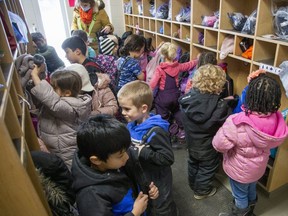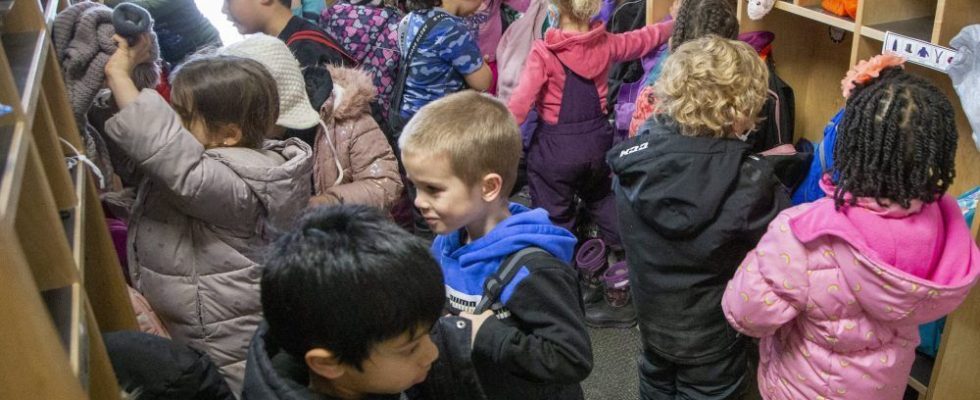More than 100,000 London-area kids head back to class in less than two weeks.

More than 100,000 London-area kids head back to class in less than two weeks. Along with the usual excitement and stress, parents, children and teachers wonder what a return to normalcy looks like and what to expect in terms of post-pandemic health measures when school resumes.
Advertisement 2
There is a new highly mutated COVID variant called BA.2.86 showing up in some countries, but not yet in Canada. The southern hemisphere, particularly Australia, just had a particularly busy resurgence of seasonal flu, COVID and RSV (respiratory syncytial virus) that sparked a rise in hospital visits by children. Their fall and winter is often a yardstick of what will be coming north.
Ontario Medical Association president Andrew Park, a London physician, led an expert panel Thursday with Vinita Dubey, Toronto Public Health’s associate medical officer of health; Children’s Hospital of Eastern Ontario child and adolescent psychiatrist Katherine Matheson; and Richa Agnihotri, a Niagara region pediatrician, to discuss vaccines, screens, masks and the importance of preventive health measures in the return to learning.
Advertisement 3
Q: Will kids be returning to 2019-era classrooms of no masks, no social distancing and in-person learning?
Dubey: It’s the first year since the pandemic was declared over, but COVID is still here. There will be an updated booster in the fall for adults, probably available for children. Getting that fall COVID booster will help us enhance our immunity to help us prevent getting sick from it. We know it’s been some time for a lot of our population and that immunity is waning. We need to remember, although children have not gotten very sick from COVID, they can still get long COVID (with symptoms of poor concentration and fatigue). The flu and COVID vaccine can be given at the same time. The preventive measures we learned and reinforced during the pandemic, they still work. If you’re sick or your child is sick, staying at home will prevent spreading. When symptoms improve for 24 hours, you can return to school. Washing our hands, covering our coughs, spending time outdoors as much as possible, we can’t lose that. If we have a weak immune system, if we’re senior, if we’re around our loved ones, we can protect them further. Masks are something we can consider.
Advertisement 4
Q: How can we help our children adjust to routine changes as we move from unpredictability at school to more normalcy?
Agnihotri: Meet the child where they are developmentally, academically and socially. Anticipate some challenges that may arise from going from summer to the school year and help them gain some tools to overcome these challenges. Create a predictable routine so your child feels that sense of security. A visual schedule can help them feel safe, secure and build resilience. Ensure sleep is a top priority because children need good quality and quantity of sleep in order to enhance their learning, growth and overall well-being. A healthy relationship with your child is very important. The things we say, the things we do can have lasting impacts. Spend quality time daily with your child.
Advertisement 5
Q: Historically, have COVID and flu vaccination rates been as high as they should be?
Dubey: No. We know for COVID vaccination rates, those 12 and over had very high rates. Ages five to 11 was next, but we know our youngest kids didn’t really get vaccinated for the most part. In general, children tend to have very low vaccination rates. We know flu can be very serious for children and the flu vaccine is very safe and seems to be a good match, at least in the southern hemisphere this year. Going into the fall, I would really recommend parents get the flu vaccine for their child. The COVID booster will likely be one for everyone based on the age it’s authorized so those two vaccines can be given at the same time. Wait until the fall because we’re expecting an updated booster to be available. It will also give them that protection when we expect the virus to increase in the fall. We recognize how important it is for children to attend school. The goal now, in the coming years, is to recover the losses from the pandemic.
Advertisement 6
-

More screen time, higher depression levels for kids: Western study
-

First day of school will be PA Day for 110,000 London-area students
Q: What are the lasting effects of screen time on our kids and what are the current guidelines for using those devices?
Matheson: A recent Ontario study shows screen time has doubled from pre-COVID levels, which is not a surprise. In a time where screens have become the norm and an electronic babysitter, it’s crucial to make parents and educators aware of the risks of excessive screen time. We know children’s brains develop in the context of safe, stable, nurturing relationships. That means they learn best in face-to-face interactions with caring adults. Too much screen time can increase your child’s risk of becoming overweight, experiencing slow language development and early reading skills, becoming nearsighted and having sleep problems and difficulties in learning. The Canadian Pediatric Society discusses minimizing screen times by setting limits. Ages two to five, no more than one hour of screen use time daily and none for kids under two. Turn off screens an hour before bed time to increase sleep quality. We’ve seen just the tip of the iceberg in terms of impacts. Much of the data is looking at long-term implications.
Advertisement 7
Q: Is children’s mental health of greater concern post-pandemic?
Matheson: Presentations of children with severe mental health issues are increasing. In our emergency department, more children are presenting with suicidal ideation and risk. On our inpatient unit, the prevalence of eating disorders has gone up and depression and anxiety (up). Kids in kindergarten, grades 1 and 2 are presenting with mental health symptoms in rates we have never seen before. Kids under the age of six, parents are noticing huge challenges. That makes sense with the cohort of those young during the pandemic. A lot of children haven’t had access to quality child-care, social learning opportunities and have grown up with stressed-out caregivers. It’s a mental health tsunami and I expect that’s going to continue.
Advertisement 8
Q: What should the province be doing to keep schools safe and has the time for masks completely passed?
Dubey: Having soap in the dispensers at school, making sure we have running water (and) hand sanitizer readily available. I think those are things from the pandemic that have carried on, including more cleaning of commonly touched surfaces and the push to spend as much time outdoors as possible. We have not thrown the masks out by any means. We’re just recommending we use it based on the circumstance. When we had mask recommendations in place, it was because the risk was very high. That’s something we can see into the fall and winter, too, as the risk increases. If you have an (elevated risk), you may take more precautions as well. The role for the mask has not gone. It’s a risk-based approach in terms of its use in risk to the population and your own personal risk.

Comments
Postmedia is committed to maintaining a lively but civil forum for discussion and encourages all readers to share their views on our articles. Comments may take up to an hour for moderation before appearing on the site. We ask you to keep your comments relevant and respectful. We have enabled email notifications—you will now receive an email if you receive a reply to your comment, there is an update to a comment thread you follow or if a user you follow comments. Visit our Community Guidelines for more information and details on how to adjust your email settings.
Join the Conversation